Blockade Billy / Stephen King
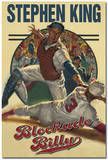 Cemetery Dance / April 2010
Cemetery Dance / April 2010
Reviewed by: Blu Gilliand
It’s a well-documented fact that Stephen King loves baseball. The avid Boston Red Sox fan co-wrote Fatihful (with Stewart O’Nan) chronicling a season with his favorite team, featured a former Red Sox player in his novel The Girl Who Loved Tom Gordon, and wrote “Head Down,” a lengthy essay about his son Owen’s Little League team that was reprinted in his collection Nightmares and Dreamscapes. So, while publisher Cemetery Dance’s recent announcement that they were releasing a new novella by King in April was a surprise, the fact that it’s about baseball should be less of a shock.
Blockade Billy is the story of William Blakely, a rookie catcher for former major league franchise the New Jersey Titans. Never heard of them? That’s because they’ve been relegated to footnote status, while Blakely himself has been scrubbed from the record books entirely. The reasons why are the subject of this tale, as told to a “Mr. King” by our narrator, former Titans third base coach and equipment manager George “Granny” Grantham.
When it comes to bringing the voice of common working Joes to life, nobody is better than King. Granny is from the old school, back when ballplayers made less than high school teachers, and he proves to be an engaging storyteller as he guides us through Blakely’s short career.
Blakely comes to the Titans when the team’s two catchers go down in the preseason – one to injury, the other to the law. Meant to be a fill-in until somebody else – anybody else – is available, Blakely proves to be a solid hitter and an unmovable object behind the plate. But something’s off about the player (who, by the way, wears number 19 – a number that should be familiar to fans of King’s Dark Tower series). He talks to himself, for one thing, and refers to himself in the third person. (“Yeah, Billy can hit here,” he says upon seeing his new team’s home field for the first time.) But his secrets run darker and deeper than anyone on the team can imagine.
King has done some of his best work in novella form, and while this may not rank as high as “Rita Hayworth and the Shawshank Redemption” or “The Body,” it’s a fun read. King’s love of the game infuses every page, and he’s clearly having a blast inhabiting the veteran voice of Granny. Cemetery Dance has given baseball fans and readers alike a fantastic season-opening gift in Blockade Billy — snag one while you can.
Purchase Blockade Billy by Stephen King.
The Road Out of Hell: Sanford Clark and the True Story of the Wineville Murders / Anthony Flacco with Jerry Clark
 Union Square Press / November 2009
Union Square Press / November 2009
Reviewed by: Joan Turner
The Road out of Hell: Sanford Clark and the True Story of the Wineville Murders by Anthony Flacco is the nightmarish account of the murders behind the Clint Eastwood and Angelina Jolie film Changeling. This disturbing true crime story reveals how Gordon Stewart Northcott took his thirteen-year-old nephew, Stanford Clark, from his home in Saskatoon, Canada, to the tiny community of Wineville, California, near Los Angeles where, through torture and rape, he held him prisoner for two years while Northcott abducted, raped, tortured and killed over twenty boys from the surrounding area.
Continuously beaten, dazed and threatened with death, Sanford was forced to bury or burn the human remains, sometimes even to inflect the fatal blow, thereby becoming an unwilling accomplice to his uncle’s psychopathic schemes.
Flacco wove the story together from the account of Jerry Clark, Sanford’s oldest son, who learned the events from his father when he was seventeen, as well as from court records, family documents, photographs and recollections. It is a brutal and heartrending tale, difficult to read and impossible to put down.
The story begins in 1928, when Sanford’s mother Winifred – Northcott’s sister – allows her younger brother to take Sanford, the older of her two boys, with him to California on the pretense of providing a firm and guiding hand in the boy’s upbringing. On an isolated chicken ranch near Los Angeles, Northcott’s intentions quickly become clear, as the secluded ranch becomes a killing ground where Northcott brings his victims, many the young sons of immigrant workers in the area. Being forced to participate in the atrocities, Sanford is held in the grip of guilt and fear of public condemnation as well as his uncle’s brutality. He is too terrified to seek help or try to escape. His only comfort is in knowing he has done his best to save those he could.
Anthony Flacco, author of the historical crime novels The Last Nightingale and The Hidden Man and the true crime book A Checklist for Murder, handles this grim, bizarre story with empathy and restraint, covering all the important details, but focusing not on the gore – of which there is plenty – but on the psychological terror endured by the child Sanford Clark. The book reads like a novel, suspenseful and chilling, and the story wraps its fingers around your throat and refuses to let go.
Sanford’s story, as horrific as it is, could easily have had a tragic ending, but it becomes instead a story of courage and redemption. The Road Out of Hell is a story of hope, and a book no fan of true crime should miss.
Purchase The Road Out of Hell: Sanford Clark and the True Story of the Wineville Murders by Anthony Flacco with Jerry Clark.
Lesser Demons / Norman Partridge
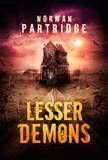 Subterranean Press / April 2010
Subterranean Press / April 2010
Reviewed by: Blu Gilliand
If, in writing this review, I was to use the style that Norman Partridge employs in Lesser Demons, I might say something like this:
"Lesser Demons by Norman Partridge is a collection of tales as hard as sun-bleached bone and as sharp as Hell-forged steel. These are stories that dig deep into your gut, claw your heart out of your chest, and force you to watch as it shudders through its last desperate beats."
Partridge’s new collection from Subterranean Press is a tantalizing mix of hard-boiled noir and supernatural otherworldliness, combining the genres and styles that cemented his love for words into a unique style all his own. In this book you’ll find more than a hint of The Twilight Zone bumping up against the staccato prose of crime fiction and the gleeful insanity of drive-in monster movies. Each of these stories borrows liberally from these influences and more, yet they all stand strong as complete and original works of their own.
Among the standouts is “The Iron Dead,” a previously unpublished novella introducing Chaney, a wandering hero in the grand pulp tradition of wandering heroes. Chaney has an iron hand that is literally straight out of Hell, and it serves him well as he clashes with a growing army of flesh/machine hybrids that would send the Terminator crying to his mommy. Partridge moves the story along at a blistering, blood-drenched pace that barely gives you time to gasp for air.
“Road Dogs” is equal parts werewolf tale and revenge story. No moonlit moors or gypsy curses here, just the hot Arizona sun and cold-blooded murder. “The Fourth Stair Up from the Second Landing” is one of the collection’s quieter pieces, but it’s a powerful ghost story that doesn’t have to shout to be heard loud and clear. “Durston” is a western with a decidedly nourish pedigree.
Partridge caps off the book with a feature that I wish more writers would try – a story-by-story breakdown that serves as the author’s commentary on the preceding tales. I’m one of those readers who loves getting a writer’s insight on his work, and Partridge gives a warts-and-all peek behind the curtain that doesn’t disappoint.
Partridge may be best known for his Halloween novella Dark Harvest, but I think that’s going to change with the release of Lesser Demons. This is a ferocious piece of work, and should vault the author to new heights of respect and recognition.
Purchase Lesser Demons by Norman Partridge.
Phoenix and the Darkness of Wolves / Shane Jiraiya Cummings
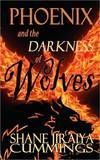 Damnation Books / December 2009
Damnation Books / December 2009
Reviewed by: Michele Lee
Damnation Books has been putting out a number of good, solid reads thus far in its brief history. But none so far have been of the same caliber in the dark fantasy genre as Phoenix and the Darkness of Wolves by Shane Jiraiya Cummings.
In this post-apocalyptic fantasy tale, Damon – once a magician in the truest sense – hunts the charred scar that used to be Australia alone, trying to catch a literal phoenix and outrace the trapped, damned souls of his family that have been turned into shadowy wolves. Damon's own role in the event that ended the world comes to light for readers during the story, making him something between hero and anti-hero.
Conventional wisdom tells writers to begin as close to the end of their story as they can to keep the tale tight. Cummings, perhaps adhering to this, begins what could have been an interesting dark urban fantasy tale after the end, while avoiding an overwhelming sense of hopelessness or despair. Cummings' world is sterile, ashy and empty, but Damon is fueled by the hope, which exists as a near-certainty, that he will reach his phoenix and be able to change things.
Phoenix and the Darkness of Wolves is short, too brief at times, giving it a movie-like feel as it sticks close to the absolute essentials instead of wandering around in extra padding. It also manages to be leisurely beautiful in its world and character-building, accentuated by its race against time, rather than driven by it.
Cummings spins a tale unique in its setting, intent and feel that is well worth the read and really should earn some well-deserved attention.
Purchase Phoenix and the Darkness of Wolves by Shane Jiraiya Cummings.
Enter Death, Stage Right / William A. Veselik
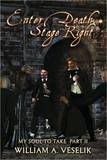 Mundania Press / May 2009
Mundania Press / May 2009
Reviewed by: Derek Clendening
Sometimes vampires are closer than you think; and, if you live across the Atlantic on the British Isle, you might find London’s theatre district swarming with them. In Enter Death, Stage Right, author William Veselik picks up right where he left off in Corpses so Lively: My Soul to Take. Professor Alfred Rhys Smythe, who has recently returned home after several years abroad to take a teaching job, is faced by a London vampire panic. At the end of My Soul to Take and the beginning of Enter Death, Stage Right, Smythe tends to his mother who has been attacked by vampires.
Any fan of Christopher Lee will find an immediate resemblance to the old Hammer film style in the novel. This is the type of vampire/horror fan that the novel will appeal to the most. Veselik also generates some appeal for the more casual vampire fan, who may enjoy the unconventional setting and the different light in which he casts his bloodsuckers. If you’re tired of the purely romantic vampire novels on the drug store rack, this might be a breath of fresh air. Fans of Laurell K. Hamilton and L.A. Banks, however, might find themselves disappointed, as will purveyors of the purely gothic vampire and Twilight groupies. Fans of traditional vampires – and all the stakes, mallets, and crucifixes that accompany them – should be pleasantly surprised.
If you plan to pick up Enter Death, Stage Right, you are well advised to pick up the first novel in Veselik's planned trilogy and read it first. While the second novel starts off fast and strong, it doesn’t strike this reader as a standalone novel — potentially problematic for the impulse buyer. As mentioned, if you’re a fan of the traditional vampire, this book is perfect for you. But those who crave a more imaginative vampiric vision should be warned that the novel offers nothing resembling groundbreaking. The writing and storytelling are passable, but neither is of the caliber that will grab you, hold your rapt attention, and make you beg for more. This is generally forgivable, but this reviewer didn’t find himself terribly inspired by the novel.
If you’ve enjoyed the first two novels, a third and final installment is forthcoming from Mundania Press.
Purchase Enter Death, Stage Right by William Veselik.
The Lucid Dreaming / Lisa Morton
 Bad Moon Books / August 2009
Bad Moon Books / August 2009
Reviewed by: Anthony J. Rapino
In her new novella, The Lucid Dreaming, Lisa Morton takes an apocalyptic theme and doses it with psychotics until the usual notion of the apocalypse is a mere fever dream. Inject a searing-dry wit and cynical, post-punk protagonist, and you’ve got a night terror of a tale.
Ashley, or as she prefers, Spike, is released from her cell in the Oxnard mental institution to find she is the only sane person left. Everyone she encounters is disoriented and acting peculiar. With the help of some old newspapers, she deduces that the entire world has been infected with a “dreaming sickness,” causing them to behave erratically and often violently. Being a paranoid schizophrenic, Spike is on a strict regimen of Prolixin, which she discovers is a temporary cure as it’s in the bloodstream.
Spike manages to make off with a stash of the drug and an abandoned car with the unrealistic hope she will find her friend Tommy. When this proves fruitless, she teams up with Teddy – a passive lucid-dreamer she finds outside a grocery store – and hits the road.
On the way to their destination, they are captured by a group of rednecks in Arizona, where they are forced to work for their daily dose of Prolixin. When life on the ranch takes a turn for the worse, Spike realizes she either has to escape or become imprisoned in an endless dream state.
While some scenarios found in The Lucid Dreaming are familiar – waking in an insane asylum to find the world has gone to pot evokes images of both 28 Days Later and In the Mouth of Madness – Morton’s new twist on an apocalyptic epidemic wrestles any familiarity from your grip and plunges you into a wholly unique experience. Add to this a cast of inimitable characters, a distinctive point of view, and genuine humor, and Morton effectively sets her tale apart from all others in this category.
At times, the first person point of view can sap immediacy from The Lucid Dreaming. Yet with a deft hand Morton again overcomes by engulfing the reader in Spike’s thoughts and emotions. Within mere pages one is captivated, seeing the world through a violent schizophrenic’s eyes. It isn’t until the mind-bending finale that the reader will step back and truly consider the truth of the events Spike has shown them.
The Lucid Dreaming is one candy-coated pill you should swallow willingly.
Purchase The Lucid Dreaming by Lisa Morton.
The Day Before / John Skipp and Cody Goodfellow
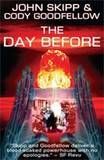 Bad Moon Books / October 2009
Bad Moon Books / October 2009
Reviewed by: Joan Turner
John Skipp and Cody Goodfellow are the dynamic duo of horror fiction, and their post-apocalyptic novella The Day Before just may be their best effort yet. Los Angeles has been hit by a nuclear bomb, with North America reduced to radiation-filled ash and survivors reduced to desperate starving cannibals. Now, six months later, an unscrupulous Hollywood director is making a movie about it. Suburb writing, characterization, dark humor and suspense make The Day Before a wild, crazy and thoroughly enjoyable ride into destruction.
The day after the President is assassinated, someone pushes the button blasting Los Angeles and turning civilization into a blazing inferno. Peter Kornberg, a film director working on a new script, is staying in a cabin in the hills on Catalina Island. He escapes the explosion, and the winds keep the heaviest fallout away. Still, the island is not spared. A crew of renegade U.S. Navy seamen disembarks on the shore, and proceeds to burn, loot, steal the women and cannibalize the men. Kornberg records the atrocities on camera.
“I should bury them,” he thinks of the bones of the massacred. “I should erect a shrine, a monument, and compose a noble epitaph. They didn’t fall like the Spartans, and nobody would go to heaven following in their footsteps. If they had anything worth passing on to the future, it was their good fucking luck. But once, they made movies and sang songs and wrote books and they tried to keep the torch lit.”
Kornberg, who appears to be the last survivor on the island, expects to die there. However, Julian Harvey, the equally unscrupulous Hollywood producer who took from him a script he had written and sold to Dreamworks, arrives onboard a submarine with a ragtag film crew he has managed to assemble and offers Kornberg the opportunity to direct a movie about the nuclear attack.
Kornberg hates the man for taking his script and the resulting dissolution of his marriage. He vows never to work with Harvey again. But, as Harvey tells him:
“The world has fallen down, true. All the big cities are gone. All our friends and family, all the people and places we loved have been erased. The ones who lived through it are fighting against a perfectly natural despair. Even if they can feed themselves and find shelter and clean water, they won’t be any better than animals if they stop believing in the big lie that civilization carried on for the last thousand years.
They need a new mythology. If they’re going to beat the despair that’s eating them up, they need to see somebody take responsibility for what they did, and repent of it, and try to make the world a better place…”
Cast as lead is Charlie Beecher, a washed-up soap opera actor and alcoholic who resembles power hungry Ellison Boyle, the former Secretary of Defense who was sworn in as Vice President on the morning after the President was murdered and the day of the nuclear attack.
Kornberg reluctantly gives in and agrees to direct the film and they set off for Long Beach to begin filming. When they arrive, survivors rush down to attack them with homemade weapons, but Harvey’s crew opens fire. They are expected to be shooting blanks but some of the bullets are real, and casualties occur on both sides before the natives withdraw.
Through all the turmoil, Harvey commands them to keep filming, allowing nothing to stand in the way of his movie. A few minutes later, two Chinook helicopters and an Apache gunship arrive, their crews also in Harvey’s employ. He has the crew, the equipment, and the work force to see his movie through at all costs.
As the filming continues and the story comes together, some of the actors grow to believe in the project, and their faith in the value of the work they will leave behind carries them all the way to Ground Zero, the radiation dense crater of Los Angeles.
In his Acknowledgments, John Skipp calls The Day Before a “painfully comical love song of hope and doom” and it is that. The story is beautifully written and at times deeply moving. Throughout the satire, violence, horror and tragedy – or perhaps because of it – the cautionary message stands out crystal clear:
“…it didn’t matter how it happened, anymore than it mattered all the times it almost happened. The men in power had fallen down on the job, and now there were no more countries, because some assholes believed lies some other assholes told them, that they could do it and survive, that they could win. And the world had let them make such awful weapons and whip them around on the global stage.…”
No matter what else you read this year, this is one blockbuster story you should not miss.
Purchase The Day Before by John Shipp and Cody Goodfellow.




